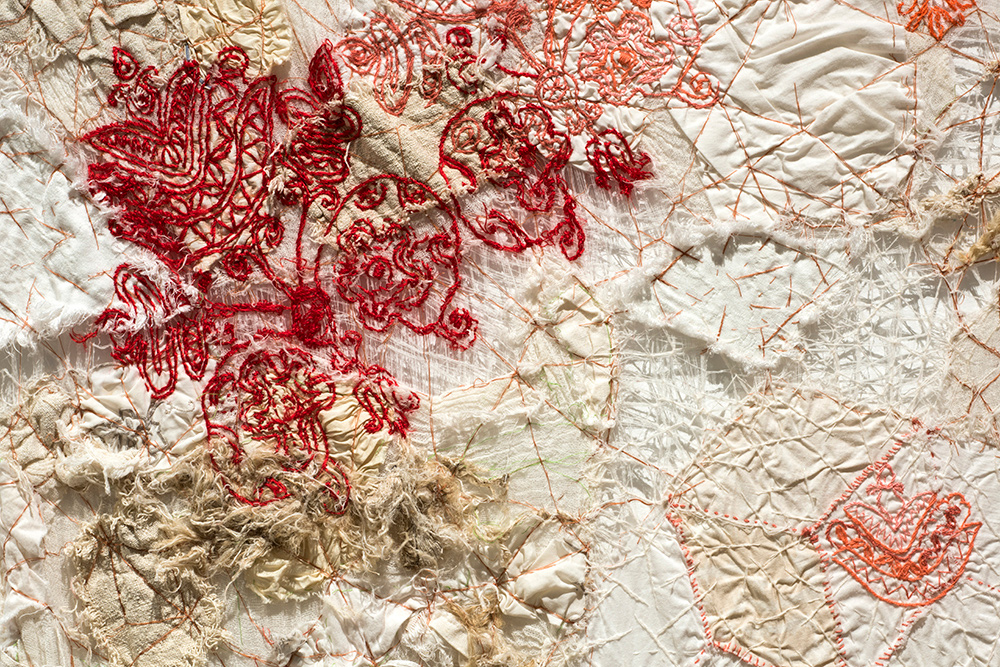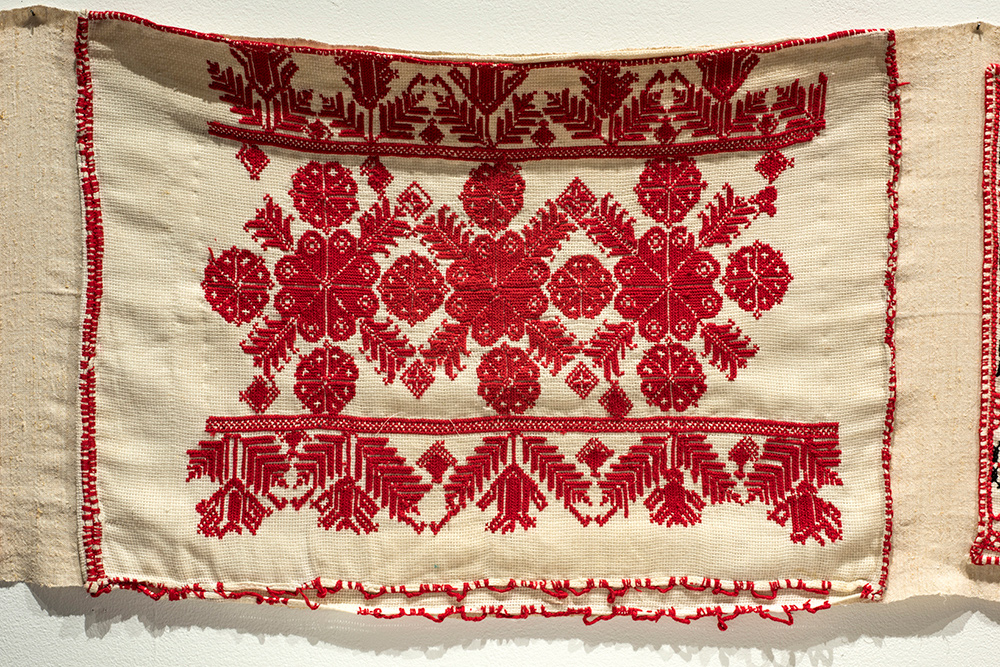I am fascinated by the textile material, hand embroidery and sewing, often telling stories with hand-stitched, salvaged textiles. I make assemblages and installations.
My attention recently turned to observe and revisit fragmentation and its manifestation in nature, cultural symbols, human body and embroidery patterns.
This subject became important on a personal level also; I see immigration, aging, loss and generational differences as fragmentation of life.
A few years ago I lost my dear family member in Hungary. We lived separate lives divided by my immigration. She became an elderly person without feeling the close warmth of immediate family. This fact disturbed me greatly, and I figured out an embroidery project that could be conducted over distance, built on occasional personal visits.
The traditional cross-stitch patterns with red yarn are well known in Hungary, a common language; we all learned the patterns and technique as kids. I encouraged her to make new pieces, even after a stroke when she barely could move her hands. When my friend turned 90, she moved to a long-term care home. She was determined to adjust herself to the change. The handwork came again to help, occupying her hand and soul while her thoughts were with us.
My installation work, RED FRAGMENTS, records this collaboration and also revisits my immigrant past through my folk art heritage. I want to point out with this installation the tension between coherent designs and fragmented pieces, the beauty of unfinished works. The embroidery fragments clearly show the persistence and try-again attitude until the prepared small canvas with the red-threaded needle runs empty, unable to be touched by her hands anymore.
Born in 1952, Anna Torma grew up on a farm in Hungary, where she learned the techniques of hand sewing and embroidery from her mother and grandmother. She enrolled at the Hungarian University of Applied Arts in Budapest in the late 1970s, at a time when censorship constricted many aspects of cultural expression. However, as textile arts were treated as domestic craft rather than a recognized artistic discipline, Torma and her contemporaries enjoyed unusual creative freedom. Torma’s hand-stitched pictorial surfaces reflect the artist’s rich family history as expressed through a matrilineal needlework tradition. Torma immigrated to Canada in 1988 and since 2002 has lived and worked in Baie Verte, New Brunswick.
Torma has exhibited her work internationally and is represented in public collections including the Museum of Art and Design, New York, Foreign Affairs Art Collection, Ottawa, Ontario, New Brunswick Art Bank Art Collection, Fredericton, New Brunswick, and Mint Museum of Craft and Design in Charlotte, North Carolina. In 2007 MSVU Art Gallery presented an exhibition of her embroidered and printed wall hangings entitled Anna Torma: Needleworks. Torma holds the New Brunswick Lieutenant- Governor’s Award for High Achievement in Visual Arts.
From the Artist
Audio Transcript
The subject matter of this exhibition is traditional red Hungarian folk embroidery pattern, used by an elderly person hit by a stroke. In parallel, in my work I re-use, cut and stitch similar patterns to create wall pieces for exhibition after having immigration to Canada seeking new identity and visual language.
The medium is textile. I am fascinated by textiles, hand embroidery and sewing, telling stories with hand-stitched, often salvaged materials formed into assemblages. In this installation I use textiles pieces from with authentic Hungarian red cross stitch patterns as a starting point. As the fragmentation theme develops, a new kind of beauty arises.
The textile assemblage allows me to use a wide range of subjects and to show the connections between them. You might want to compare the domestic uses of hand embroidery with my artistic approach to re-arrange my inherited folk culture, to make a new aesthetic in a new home-place.
A few years ago I lost my dear relative, Ilona, in Hungary. We lived separate lives, divided by my immigration. She became an elderly person without feeling the close warmth of immediate family. This fact disturbed me greatly, and I figured out an embroidery project which could be conducted over distance, with occasional personal visits.
The traditional cross stitch and hand embroidery patterns with red yarn are well known in Hungary; we all learned the patterns and technique as kids. I encouraged Ilona to make new pieces, even after her stroke, when she could barely move her hands. When she turned 90 she moved to an old people’s home. She was determined to adjust herself to the change; the handwork came again to help. It occupied her hands while her thoughts were with us.
My installation work Red Fragments records this collaboration and also re-visits my immigrant past through my folk art heritage. I want to point out with this installation the tension between coherent designs and fragments, the beauty of unfinished works. The embroidery fragments show the persistence and “try again” attitude until the prepared small canvases with the red-threaded needle run empty, unable to be touched by her hands any more.
Red Fragments
Textile assemblage with Hungarian folk art, commercial and silkscreen prints, woman’s handwork, hand embroidery on North American quilt patterns (touchable) 200 cm x 30 ft. 2017


(Anna Torma with Ilona Klocza, Red Fragments, 2017
Textile assemblage with Hungarian folk art, commercial and silkscreen prints, women’s handiwork, hand embroidery on North American quilt patterns (touchable) 200 cm x 30 ft.)










